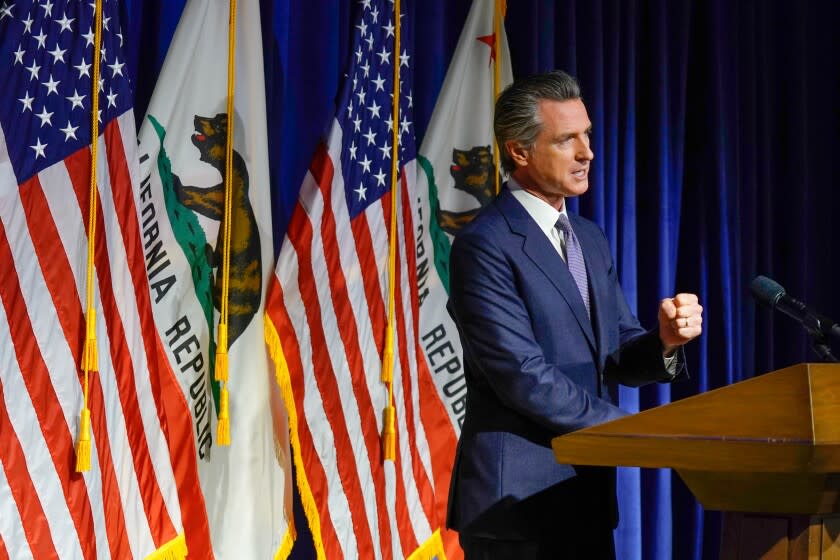Editorial: The pandemic is still raging and workers still need sick leave protection

- Oops!Something went wrong.Please try again later.
- Oops!Something went wrong.Please try again later.
There is a terrible disconnect in California’s pandemic policies. The Omicron variant has fueled a surge in COVID-19 cases and quarantines, prompting millions of Americans to call in sick this month. Classrooms and day-care centers have closed because of outbreaks, forcing parents who aren't sick to take time off. And yet a key pandemic protection for workers — extended paid sick leave — expired last fall.
That means some workers are forced to forgo pay if they contract COVID, need to quarantine or stay home with their child. Employees who can’t afford to miss a paycheck may show up to work sick and expose others to the virus.
Now Gov. Gavin Newsom and legislative leaders have reached a deal to restore the much-needed benefit through September. The agreement announced Tuesday would require California employers with 26 or more employees to provide up to 40 hours of flexible paid leave for full-time workers who are sick or need to quarantine after an exposure, or who need time off to care for a family member in COVID isolation or children whose schools were closed by the virus. An employee would qualify for an additional 40 hours of paid sick time if he or she tests positive for COVID.
If approved by the Legislature on a fast track and signed into law, the paid leave would be retroactive to Jan. 1, meaning employers would have to reimburse workers who had taken qualified unpaid time off this month.
Nearly two years into the pandemic, it should be clear that paid sick leave is not just a worker protection — it's public health protection, too. There is a broad societal interest in making sure employees can afford to stay home when they’re sick, especially when we're facing a highly contagious and potentially deadly virus.
Early in the pandemic, Congress ordered most companies to provide two weeks of paid sick leave for employees who were quarantining for COVID symptoms or caring for a child whose school was closed by the virus. It was the first nationwide sick leave and it expired at the end of 2020.
In March, Newsom signed a bill that required California employers with 26 or more employees to provide up to 80 hours of paid sick leave for workers with COVID symptoms or a diagnosis, or those caring for a family member in COVID isolation or children whose schools were closed by the virus. The policy also allowed paid time off for employees to get vaccinated and to recover from vaccine-related side effects.
But that broad mandate for paid leave expired at the end of September. The state still requires that some workers get paid for 10 days if they get sick or exposed to the virus. But that doesn’t include employees who were infected outside of the workplace or those who have to miss work to care for sick family members or children whose schools are closed.
Newsom said earlier this month that he intends to bring back the state’s supplemental paid sick leave temporarily. But the clock is ticking, and state leaders have been moving too slowly at a time of record-high cases. The Omicron surge started last month, and during the peak, earlier this month, the state reported around 120,000 cases a day — the highest of the pandemic.
It's good that state leaders have reached a deal to revive supplemental paid leave, but the policy shouldn’t expire until the pandemic is over. People shouldn't face financial pain if they get COVID or have to take time off work to care for a COVID patient or child forced out of school.
Nor should employers be stuck with the full cost of providing this essential benefit, even as they are struggling to operate with reduced staff. As part of early COVID relief efforts, the federal government provided tax credits to help cover the cost of the extended sick and family leave. The Biden administration and Congress extended the tax credit, but it expired in September, and there’s been little progress in reviving the aid at the federal level.
But that’s no reason for California to stiff employers. The proposal announced Tuesday does include direct aid for companies to offset the expense of paid leave. Instead lawmakers said they are pushing a broader package of tax relief for California businesses, plus additional small business grants. Given the state's large surplus, it can afford to help cover the cost of pandemic paid leave to aid families and communities.
This story originally appeared in Los Angeles Times.

